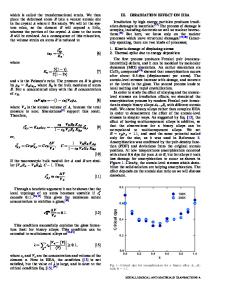On the role of heterogeneity in concentrated solid-solution alloys in enhancing their irradiation resistance
- PDF / 961,848 Bytes
- 10 Pages / 584.957 x 782.986 pts Page_size
- 119 Downloads / 822 Views
EARLY CAREER SCHOLARS IN MATERIALS SCIENCE 2020
On the role of heterogeneity in concentrated solidsolution alloys in enhancing their irradiation resistance Shijun Zhao1,a) 1
Department of Mechanical Engineering, City University of Hong Kong, Hong Kong, China, 999077; and Shenzhen Research Institute of City University of Hong Kong, Shenzhen, China, 518057 a) Address all correspondence to this author. e-mail: [email protected] This paper has been selected as an Invited Feature Paper. Received: 15 September 2019; accepted: 14 October 2019
Concentrated solid-solution alloys (CSAs) demonstrate excellent mechanical properties and promising irradiation resistance depending on their compositions. Existing experimental and simulation results indicate that their heterogeneous structures induced by the random arrangement of different elements are one of the most important reasons responsible for their outstanding properties. Nevertheless, the details of this heterogeneity remain unclear. Specifically, which properties induced by heterogeneity are most relevant to their irradiation response? In this work, we scrutinize the role of heterogeneity in CSAs played in damage evolution in different aspects through atomistic simulations, including lattice misfit, thermodynamic mixing, point defect energetics, point defect diffusion, and dislocation properties. Our results reveal that structural parameters, such as lattice misfit and enthalpy of mixing, are generally not suitable to assess their irradiation response under cascade conditions. Instead, atomic-level defect properties are the keys to understand defect evolution in CSAs. Therefore, tuning chemical disorder to tailor defect properties is a possible way to further improve the irradiation performance of CSAs.
Shijun Zhao
Dr. Shijun Zhao is an Assistant Professor at City University of Hong Kong. Dr. Zhao received his Bachelor’s degree in Physics in 2008 and his Ph.D. degree in Nuclear Engineering in 2013, both from Peking University. His Ph.D. research centered on the radiation effects in ceramics and low-dimensional materials based on ab initio methods and molecular dynamics simulations. After graduation, Dr. Zhao conducted his postdoctoral research at the College of Engineering at Peking University for two years, with a focus on excited electron dynamics in materials under high-energy ion or laser irradiation using ab initio methods. Prior to joining City University of Hong Kong in 2018, he was a postdoctoral research associate at Oak Ridge National Laboratory, working on the irradiation effects in concentrated solid-solution alloys. Dr. Zhao’s current research group works on computational defect properties. Specifically, his group aims to understand defect thermodynamics, defect production, defect migration, and defect evolution in different materials under deformation or irradiation conditions. The defects considered include point defects, impurities, dislocations, stacking faults, grain boundaries, and surfaces, etc. The materials concerned including nuclear structura
Data Loading...










